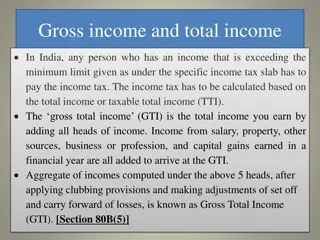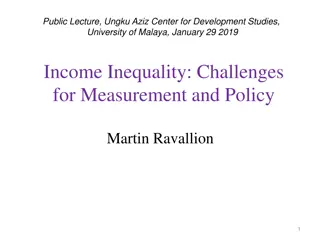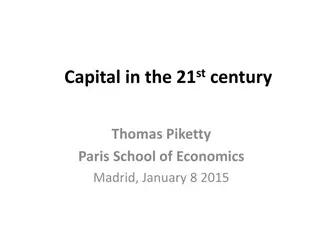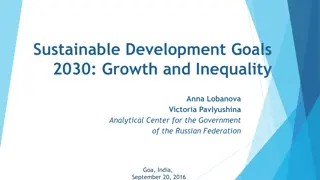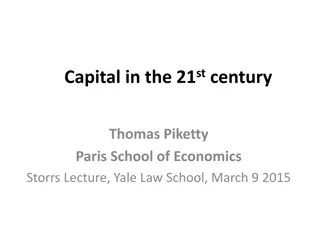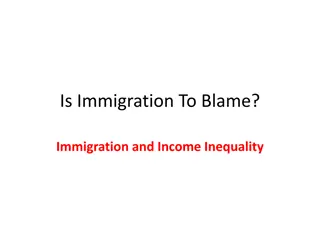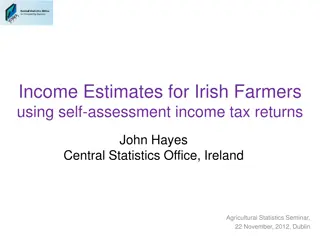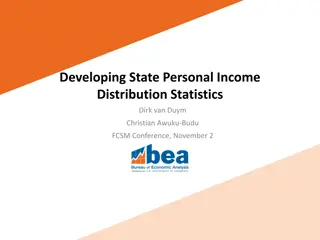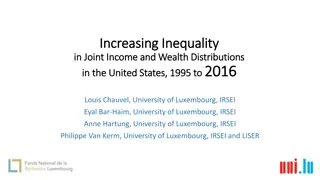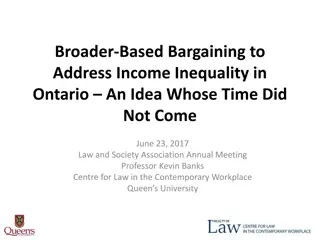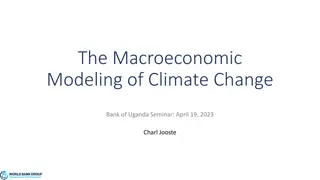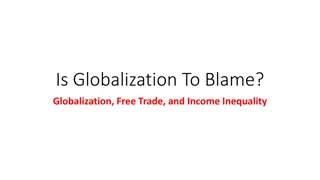Impact of Macroeconomic Factors on Income Inequality in Asia
This presentation explores the rising income inequality in Asian countries despite significant economic growth, highlighting the key determinants of inequality including macroeconomic, political, and demographic factors. Trends in income distribution and implications for inclusive growth are analyzed, offering insights for policymakers and researchers.
Download Presentation

Please find below an Image/Link to download the presentation.
The content on the website is provided AS IS for your information and personal use only. It may not be sold, licensed, or shared on other websites without obtaining consent from the author.If you encounter any issues during the download, it is possible that the publisher has removed the file from their server.
You are allowed to download the files provided on this website for personal or commercial use, subject to the condition that they are used lawfully. All files are the property of their respective owners.
The content on the website is provided AS IS for your information and personal use only. It may not be sold, licensed, or shared on other websites without obtaining consent from the author.
E N D
Presentation Transcript
Impact of Macroeconomic Factors on Income Inequality and Income Distribution in Asian Countries ADBI Workshop on Structural Transformation and Inclusive Growth 20-21 September 2016 Asian Development Bank Institute, Tokyo Japan Ravindra Deyshappriya Research Director ravindra@lki.lk The opinions expressed in this presentation are solely those of the presenter and do not necessarily reflect those of the LKI. 1
Outline of the Presentation Introduction Trends of Inequality in Asia Matters arising from reviewing the literature Methods & Results Conclusion & Recommendations 3/13/2025 2
Introduction Background of the Study In terms of growth dynamics and poverty reduction mechanism, the Asian region has achieved this in a remarkable degree, more than any other region in the world. However, income inequality across the Asian region is increasing and the inequality of more than half of the Asian countries is above the average inequality of Asia. Inequality reduces the pace at which growth translates in to poverty reduction as well (Bourguignon, 2004; Kakwani, 1993) According to Zhuang et al (2014), factors (technological improvements, market-oriented reforms and globalization) that drive Asia s accelerated economic growth have themselves caused inequality. There is a lack of updated scholarly works on macro-inequality linkages, and even existing knowledge does not provide a consensus on the linkages. Methodological issues of existing literature. 3/13/2025 3
Introduction Objectives of the Study 1. Examine the key determinants of income inequality of the Asian Countries. Observe how; 1. Macroeconomic factors 2. Political Economic factors 3. Demographic factors affect income inequality in Asian countries 2. Analyze the determinants of quantile-wise income distribution of Asian countries. 3/13/2025 4
Trends of Inequality in Asia The average Gini coefficient of the Asian region has increased from 34.5 in the 1980s to 38.3 by the 2000s In the 2000s, the inequality of 16 countries out of the selected 33 Asian countries is higher than that of the average inequality of the Asian region (38.3). 3/13/2025 5
Trends of Inequality in Asia High Income Low Income Cyprus Bangladesh Israel Cambodia Japan Maldives Russian Nepal Singapore Tajikistan South Korea Lower Middle Income Upper Middle Income Georgia India Azerbaijan Indonesia China Latvia Iran Mongolia Jordan Pakistan Kazakhstan Philippines Lebanon Sri Lanka Malaysia Uzbekistan Thailand Vietnam Turkey Yemen Turkmenistan -5 0 5 10 15 20 -20 0 20 40 Growth Rate of Gini Index 1990s-2000s Lower middle income countries have a remarkably high inequality growth rate followed by high income countries. The majority of the upper middle income countries have negative growth rate in the Gini index, except, notably, China. 3/13/2025 6
Matters arising from reviewing the literature Contradictory findings. The well-known Kuznet (1955) argument has been questioned by Bruno et al (1996), Fishlow (1995) and Deininger and Squire (1997). Calderon and Serven (2004) and Chatterjee and Turnovsky (2012) arrived at contradictory findings on government expenditure. Kraay (2004) argued that international trade benefited the poor and reduced inequality. However, Barro (2000), Bourguignon and Morrisson (1990) and Milanovic (2005) provided counter arguments. Have considered only very limited macroeconomic factors. Inflation and exchange rate (Bulir and Gulde, 1995) government debt (You and Dutt, 1996). 3/13/2025 7
Matters Arising from Reviewing the Literature Methodological Issues Time Series analysis. Maestri and Roventini (2012) Cross Sectional analysis. Sarel (1997) Exclusion of factors other than Macroeconomic variables. Maestri and Roventini (2012) Suggestions for future researchers by Sare (1997) Include fiscal policy variables and demographic variables. Employ panel data analysis. This study attempts to overcome the issues attached to the literature by incorporating the suggestions of Sare (1997) by using a large number of countries (33) over 1990-2013 3/13/2025 8
Methodology Sample Countries 33 Countries (1990 2013) Armenia Malaysia Azerbaijan Maldives Bangladesh Mongolia Cambodia Nepal China Pakistan Lbhlblbnpn Cyprus Philippines Georgia Russia India Singapore Indonesia Sri Lanka Iran Tajikistan Israel Thailand Japan Turkey Jordan Turkmenistan Kazakhstan Uzbekistan South Korea Vietnam Latvia Yemen Lebanon 3/13/2025 9
Methodology Variables Variable Name Variable used for the Study Data Source Dependent Variables Inequality Gini Index (WIID) Income Distribution Income Shares owned by Quantiles (WIID) Independent Variables Macroeconomic Variables National Production Gross Domestic Product World Bank Data Investment Capital Formation World Bank Data Changes in Price Level Inflation World Bank Data Unemployment Unemployment World Bank Data Trade Terms of Trade World Bank Data Debt Level Government Debt as Percentage of GDP World Bank Data Independent Variables - Political Economy Variables Corruption Corruption Perception Index Transparency International Political Instability Political Risk Index www.prsgroup.com Development Assistance Official Development Assistance World Bank Data Independent Variables - Demographic Variables Education Gross Enrollment Ratio Secondary Education World Bank Data Labor Force Participation Labor Force Participation World Bank Data Population Population Growth Rate World Bank Data 3/13/2025 10
Methodology Empirical Models Model 01 Measures the impact of macroeconomic factors on income inequality ???????,?= ?1 ??,?+ ?2 ??,?+ ?2 ??,?+ ?1,?+ ?1?,? Model 02 Measures the impact of macroeconomic factors on income distribution among income quantiles (?1)?,? .(?5)?,?= ?1 ??,?+ ?2 ??,?+ ?2 ??,?+ ?1,?+ ?1?,? ? - Vector of Macroeconomic Factors ? Vector of Political Economy Factors ? Vector of Demographic Factors 3/13/2025 11
Methodology Analytical Techniques Employed Generalized Method of Moment (GMM) estimation technique. Overcomes the weakness of cross-country and time series analysis. Applied the first difference of the regression equation. Avoids country specific omitted variable bias. Used appropriate instruments. Overcomes endogeneity issue. 3/13/2025 12
Results Income Inequality Factors that widen inequality Increase in lnGDP Higher Inflation Higher Unemployment Higher Terms of Trade Higher Political Risk Factors that reduce inequality Increase in the Square of lnGDP Higher Official Development Assistance Higher Education Higher Labour Force Participation 3/13/2025 13
Results Income Distribution The initial increase in GDP redistributes income from the bottom 20% of people to the middle class and the richest group. Further increases in GDP redistribute the income from the top 20% to the middle income and the poor groups. Higher inflation reduces the income share of the 1st and 2nd quantiles and increases only the share of the richest. Unemployment reduces the income share of all quantiles, except the richest. Higher education redistributes the income from richest quantile to third and the poorest. 3/13/2025 14
Conclusions and Recommendations The descriptive analysis identified that inequality in countries such as Japan, Russia, Israel, Singapore, Sri Lanka, China, India, Latvia, Bangladesh and Indonesia has been continuously increasing since the 1990s. In contrast, countries such as Iran, South Korea, Malaysia, Turkey and Pakistan have been experiencing declining inequality. There is an inverted U shape (parabolic) relationship between GDP and income inequality which is similar to Kuznets (1955) Higher inflation, terms of trade and unemployment increase inequality in Asian countries ODA, education and labour force participation reduce income equality significantly in Asian countries while political risk may marginally increase income inequality 3/13/2025 15
Conclusions and Recommendations Capital formation, growth rate of debt, corruption and growth rate of population do not significantly affect income inequality in Asian countries. An initial increase in GDP, higher inflation, and unemployment reduce the income share of relatively poor quantiles while increasing the income share of the quantiles with relatively higher income. Further increases in GDP and higher educational attainment redistributes income from higher income quantiles to lower income quantiles. Higher and long term economic growth is essential for more equal distribution together with efficient fiscal instruments that ensure fair allocation of the benefits of growth. Education should be promoted while generating more employment opportunities. Price stability and political stability should also be ensured. 3/13/2025 16
Thank You Thank You 3/13/2025 17


